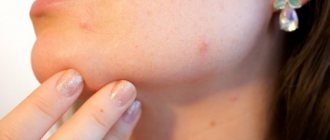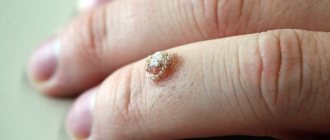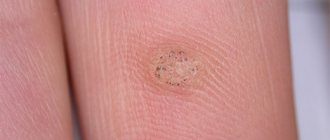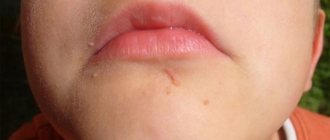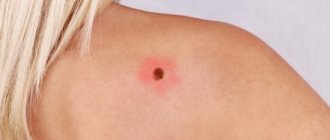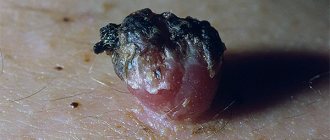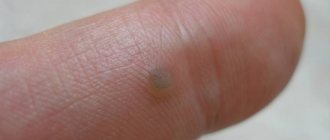Warts are benign growths that can appear on almost any part of the body. They quite often cause discomfort, since it is both unsightly and also inconvenient, because there are often cases when they appear on the neck, arms, and armpits, which leads to periodic damage to them.
READERS RECOMMEND!!!
To treat papillomas, our readers actively use the remedy... Read more
But what happens if the wart is completely torn off or just severely damaged? Of course, in such cases you should not panic or, on the contrary, not pay attention; you just need to visit a specialist who will solve this problem.
Causes and types of warts
In medical practice, there are several types of warts. It can be:
- Vulgar. This is the most famous type of growth. Appears in adults and children. They look like small cones with a loose surface. They may disappear without treatment.
- Plantar. Deep growths located on the feet or heels of the feet. They have a color from yellow to gray-blue.
- Flat. Small spots that protrude slightly above the surface of the skin. Flesh color. Often occur in patches.
- Genital warts. A cone-shaped growth that occurs mainly on the mucous membranes of the genital organs, as well as in the perineum and anus. The color is dark, the consistency is elastic to the touch.
- Thread-like. Small convex papillary growths. They appear on the neck, under the arm. The most susceptible are the injured.
The main reason why growths appear on the body is the human papillomavirus. Up to 70% of the entire population is infected with this virus, but most of them are not even aware of the disease.
HPV can manifest itself in the form of wart growth under the following factors:
- reduced immunity;
- poor nutrition;
- hormonal disbalance;
- excess weight;
- hypothermia;
- sudden weight loss;
- lack of personal hygiene.
These are the most common causes of warts appearing on the body.
Structure of a wart
The top of the growth is covered with a dense keratinized surface consisting of dead cells. These cells prevent infection from entering and infecting the wart.
Next comes the root. Blood vessels lead to it, supplying the growth with nutrients. You cannot pull out the root yourself.
Due to the proximity of the capillaries, if the growth is damaged, bleeding may begin. How abundant it will be depends on the size.
Methods for removing damaged growth
Need advice from an experienced doctor?
Get a doctor's consultation online. Ask your question right now.
Ask a free question
Surgical excision is performed for large-scale growths, suspected or confirmed cancer processes. The method is traumatic, painful, and is performed under local anesthesia. The postoperative period depends on the size of the removed element, the regenerative features of the skin, on average it is 14-30 days. Modern methods of removing damaged warts consist of using hardware techniques that are characterized by quick results, low invasiveness, and minimal contraindications.
The recovery period takes 7-14 days, after application there are no scars left:
- laser coagulation allows you to remove the deep roots of warts, leaving no traces in the form of scars;
- cryodestruction with liquid nitrogen - extremely low temperatures necrotize the growth, it falls off on its own after the procedure;
- diathermoelectrocoagulation – excision with electric loops eliminates formations in hard-to-reach places;
- radio wave method - the element melts under the influence of a radio wave field, the surrounding healthy tissues are not involved in the healing process;
- burning with acids – point cauterization with aggressive substances.
After removal, therapy with immunocorrective drugs is carried out to prevent relapse of papillomatosis.
Which warts are susceptible to injury?
Most of all, the injured are large growths that you want to pick out. It is easy to pick off such a wart by accident.
If the wart is located in a place where there is constant friction with clothing or shoes, then as it grows it can become injured and subsequently come off.
Small thread-like formations have a loose structure, so with the slightest friction they bleed and may fall off.
Condylomas and papillomas have a shape that stands out above the surface of the skin. If located in an area where there is friction with clothing or linen, it is necessary to get rid of such growths as soon as possible so that if damaged, the wound does not become infected.
Why do you need to remove papillomas?
Those who are interested in what will happen if the wart that has arisen is not removed should be aware of the possible consequences. The presence of papilloma on any part of the body can provoke the following complications:
- there is a risk of the tumor becoming malignant;
- warts can grow over time and invade healthy areas of the integument;
- there is a possibility of the occurrence of inflammatory processes in combination with bleeding and suppuration; this often happens if the growths are picked, pulled out, torn off, or cut off yourself with scissors or a blade.
An inflammatory process may begin in the wound
If the wart is not cut off on time and the pathogen begins its active activity, the likelihood of infecting strangers with this pathology increases significantly.
What actions most often cause warts to come off?
The growths located in the area of friction with clothing are torn off and pulled out at the slightest contact. If they are located in a place where a person regularly shave, careless movement can easily damage the wart.
If a wart on your hand comes off, it is mainly a consequence of frequent contact with household chemicals. A torn wart brings great discomfort.
You need to carefully monitor if growths affect the skin of small children. Children can scratch them and accidentally tear them off.
What happens if you pick off a wart?
If a wart is peeled off, it often bleeds. An open wound also appears; if an infection occurs, infection and suppuration may begin. This will prolong the healing time of the affected area.
Also, after the wound heals, a scar or scar forms, which will have to be further removed. If you accidentally puncture or tear off a wart and it starts to bleed, you should consult a doctor immediately.
What to do if you get a wart?
If a wart is completely or partially torn off, under no circumstances should you remove the remaining parts yourself. First of all, this applies to cases when it comes off completely, you need to find the torn piece of growth and place it in salt water (a teaspoon of salt per 1 liter of clean water) so that the doctor can carry out all the relevant tests when the patient gets to it. It is also worth disinfecting the area near it and protecting the wound from any infections getting there.
Often, when warts are torn off, inflammatory processes can begin, as well as many other troubles, but there is no need to be left alone with them, it is better to go to the doctor as soon as possible.
If a person has ripped off a wart, then you should expect the following unpleasant moments at first:
- When the growth is not completely torn off or is simply severely damaged, it can change color and swell;
- The skin around it becomes red and inflamed;
- The site of injury may burn and itch;
- There is a possibility of purulent discharge;
- Sometimes the growths change their shape.
When such a nuisance occurs, there is no need to pick, tear off or perform other manipulations with the growth, since even a simple wart can degenerate into a malignant formation. Seeing a dermatologist is the best decision.
How to stop bleeding
If a wart is picked accidentally or intentionally, it will begin to bleed. Also, if you notice that blood is coming from a condyloma or papilloma, this is the first sign that the wart is damaged or will soon come off.
If the wart bleeds and the bleeding is light, it can be stopped with a simple cotton pad or swab.
If there is excessive bleeding, apply a tight bandage or tourniquet. Even if the bleeding is successfully stopped, a consultation with a dermatologist is necessary. It may be necessary to remove any remaining loose debris from the wound.
If the bleeding is severe and cannot be stopped, you should consult a doctor immediately!
What steps to take next
What to do if you rip off a wart? This is a common question during consultations with a dermatologist. If you see that the wart is coming off or has already come off, you need to take action.
You need to make sure that the wound does not get infected. To do this, it should be sealed with adhesive tape. If the affected area is large, then bandage it with a bandage.
If necessary, the doctor will prescribe ointments or other medications to help promote rapid healing.
Is it possible to tear off a wart yourself?
Removing the tumor is possible, but only if you do not rip it off. The safest thing to do is consult a specialist, where there are several methods for getting rid of warts. This may be exposure to liquid nitrogen, laser, radio waves, or surgical excision.
Remember that if you are going to pick or pick off a wart, you increase the risk of cancer.
Cutting off a wart in a clinic guarantees the absence of a scar or any scar at the location of the growth. Of course, there is no absolute guarantee that the wart will not appear again.
Is it possible to get infected from a person if you touch a wound?
There are quite a lot of cases of infection of a healthy person through contact with a wound of a patient. This should not be done under any circumstances, because there is a possibility of becoming infected with the human papillomavirus. Warts appear more quickly in those who have touched the wounds with unprotected hands. This is due to the fact that the blood contains a significantly higher concentration of the virus, and the skin of any person always has microcracks that become entry points for infection.
Gloves should absolutely always be worn when treating the wounds of other people to avoid contact with the skin in large concentrations of not only HPV, but also other infections - HIV, viral hepatitis, etc.
If the bleeding does not stop and the wound needs to be treated, gloves should be worn to prevent infection.
Is it possible to cut off warts?
Many people, noticing that they have a growth, do not rush to see a doctor. Especially if the wart is in an intimate place. Many people are engaged in removing growths on their own.
As medical practice shows, those patients who independently cut off warts with scissors then underwent an additional course of treatment.
If you cut off warts at home, you will never be able to get rid of them. The root, which is the basis, will continue to be in the body, thereby giving life to new formations. It must be cut out or removed additionally.
Symptoms of wart dying
When exposed to complex therapy, suppressing the reproduction of papillomavirus, the formation begins to gradually die off. An important point is the drying of the roots.
The process when a wart dies off consists of the following signs and clinical symptoms:
- the growth externally acquires a dark gray or blue-black color, which indicates destruction of the formation, separation of connections with vascular structures;
- A slight itching of the surrounding tissue may appear due to the functioning of the immune system, healing of the wound surface after damage to the HPV lesion;
- the formation may become convex due to the replacement of the infected area with scar, connective tissue;
- the skin around the growth may become red and inflamed, but there is no pain or discomfort.
Safe symptoms of dying off are spontaneous drying, as a result of which the wart falls off. It can be observed during correction of the immune status and activation of the body’s defenses.
For any atypical manifestations of skin elements, you should seek medical help to avoid negative consequences and complications.
First aid
If a wart is cut or torn off, it begins to bleed. You should immediately consult a doctor, but before that you should provide first aid. It is as follows;
- The damaged area is treated with antiseptic agents: hydrogen peroxide, chlorhexidine.
- Then, when the wound dries, it is covered with a plaster.
- If there is a lot of bleeding from the wart, a tourniquet or bandage is applied.
- Under no circumstances should you throw away a wart. It is necessary to give it to a doctor, who should be contacted in any case, for further examination. This is necessary to exclude malignant degeneration.
What to do if injured?
If the wart has been damaged in any way, it is necessary to take a number of preventive measures. The complex is aimed at reducing the risk of the disease spreading to other healthy areas of the skin, reducing the likelihood of infection. The set of necessary actions includes treating the wound and isolating it. Recommended actions in case of damage are as follows:
If a wart is injured, treat the area with alcohol and apply a bandage.
- Wash the area with a disinfectant. It is acceptable to use medical alcohol or hydrogen peroxide. Apply a cotton swab or bandage moistened with the indicated products to the site of the breakdown and wait until the bleeding stops.
- If there is pain, you can use a local anesthetic or painkiller.
- Cover the area where the wart is torn off with a plaster and go to the hospital as soon as possible. After conducting an examination, the doctor will give recommendations on further actions.
By damaging a wart, a person risks aggravating the development of HPV disease. It is capable of affecting the skin at high speed, capturing area after area. Further complete removal of the virus from the body is possible, but this requires a significant amount of time and effort. Paying attention to your skin and performing the complex in case of damage makes it possible to quickly eliminate the disease, reducing the number of unsightly looking scars and cicatrices.
Risks arising from injury to the growth
What to do if a wart bleeds? What to do if a wart comes off? Why can’t you pick them and remove them yourself? Why did new formations appear again? All these questions arise after the job is done and the blood has flowed.
If the growth is damaged, the body risks getting an infection, which can lead to inflammation of the growth on the skin and even death due to blood poisoning.
Body temperature may also increase and the damaged area will be very painful. The formation of a bleeding wound will increase the pain effect.
When bleeding occurs, infected blood can get onto healthy skin, thereby creating an environment for the appearance of neoplasms. The wound will heal over time, but the scars and scars will remind you of themselves all your life.
Reasons for the disappearance of growths
The skin and mucous membrane perform a barrier function, protecting the internal environment of the body from external factors.
Human papillomavirus infects cells in the basal layer of squamous epithelium, which makes up the physiological barrier. This happens especially easily as a result of injury.
Having penetrated the cells, the virus has a pathological effect and disrupts vital processes. As a result, condylomas, papillomas, and warts are formed.
Local protection is due to cellular and humoral factors. The dominant role belongs to cells, represented by mononuclear cells and Langerhans cells.
They transmit the virus antigen (usually its proteins) to other immunocompetent cells (lymphocytes). T lymphocytes make it possible to identify and destroy infected body cells along with the virus.
A certain role is played by immunoglobulins (antibodies) to the virus, which are produced by plasma cells, and interferons. The mechanism works when vaccinated against papillomavirus.
Interferons provide nonspecific protection of the body against infections of viral etiology. They are produced in response to the penetration of a foreign antigen into the cell.
As a result of the influence of interferons, anabolic processes in the infected cell are disrupted, that is, protein synthesis is disrupted.
In addition, programmed cell death, apoptosis, is triggered. Interferons can increase the activity of immune cells.
They belong to humoral factors, like antibodies and interleukins. Interleukins allow cells of the immune system to interact with each other.
Violations of any of these systems lead to the active progression of HPV and warts:
- decreased immunity due to hypo/vitaminosis, taking medications that affect the immune system, serious illnesses (mainly oncology), HIV infections;
- hormonal changes: pregnancy, menopause, puberty;
- chronic diseases in the acute stage.
With the normal function of local and general immunity factors, an effective fight against the viral agent and the warts that caused it occurs.
Strengthening the immune system will help cope with the disease:
- seasonal prevention of hypovitaminosis;
- hardening;
- maintaining personal hygiene;
- balanced diet;
- active lifestyle;
- rejection of bad habits.
In some situations, when hormonal changes occur in the body, preconditions are created for the activation of the virus, which causes the appearance of growths. But after normalization of hormonal levels, the body manages to effectively fight the manifestations of infection. This applies to juvenile warts.
Formations caused by human papillomavirus can go away on their own within two years.
How long a wart goes away depends on resistance, that is, the body’s ability to resist the influence of external factors, and the reactivity of the immune system.
Factors contributing to infection cannot be ruled out and must be eliminated. Juvenile warts disappear after puberty, when the endocrine system returns to normal.
You should not hope for self-resolution of the disease. If you notice changes in the growth and understand that it will soon fall off, you should not try to speed up the process. It can cause harm and contribute to relapse.
There is no treatment that specifically targets the virus yet. Doctors try to reduce its concentration and help the patient’s body cope on its own. Sometimes this cannot be achieved. Then the disease becomes chronic.
Possible consequences
If a wart comes off and a person does not pay special attention to it, this can lead to unpleasant consequences. First, an infection may get there. Then the affected area will begin to rot and tear.
After the pus comes out, an open wound forms. When it heals, it will leave a scar.
What happens if you cut off a wart at home? The consequences of self-removal will not take long to come:
- bleeding wound;
- increased body temperature;
- painful sensations.
Treatment options at home
It’s worth noting right away that this is the most risky and unwise decision you can make. If you pull out the remnants of a wart or start treating its remaining fragment, you can use some drugs from the pharmacy for such purposes.
Must read Anogenital warts
The same “Kolomak” or “Ferezol” will make it possible to remove a damaged wart, but you should be aware that they all practically burn out the cells of the neoplasm, and with the slightest damage to the growth, this can lead to severe burns, the formation of wounds, infection and much more.
Some advise treating areas with warts with celandine, even if it is a torn wart, or using various recipes from traditional medicine. Be that as it may, there is no point in talking much about this, since we are talking about the potential development of cancer, and there is no point in thinking about any self-medication here.
Neither pharmaceutical products, nor folk recipes, nor, especially, self-removal of warts, will do anything good unless you first consult a doctor.
Precautionary measures
If it happens that a wart breaks off on any part of the body, you must adhere to the following rules:
- Never touch the torn area with dirty hands.
- If there is contact with a sore spot, you need to treat your hands with an antiseptic or wash them thoroughly with soap.
- Wound treatment procedures must be carried out with gloves.
- Do not touch the wound with your hands and do not let other people touch it except the doctor.
- Seek help from a specialist.
A growth that protrudes strongly above the surface of the skin should be under special supervision, especially for children. It is necessary to ensure that the child does not scratch or injure the infected area.
If the wart comes off and there is no way to see a doctor, the sore spot must be carefully treated with wound-healing medications. When applying the ointment, you should avoid getting it on healthy skin of the body.
In order to completely remove growths and get rid of relapse, it is necessary to strengthen the immune system, because it is precisely its decrease that provokes more and more new formations. You also need to pay attention to the appearance of redness and growths.
Modern methods of wart removal
If it happens that the future patient picks a wart, in almost any case he will have an operation to remove it, even if the root is simply left there. When the growth comes off, it must be completely removed, and this can be done in several ways:
- Surgical method of removal . In this case, the doctor simply cuts off the growth with a scalpel, and although wounds after such an operation take quite a long time to heal, the method is used often. Not everyone can afford or tolerate other methods of removal;
- Cryodestruction . A fairly popular method of removing warts, which is based on the use of liquid nitrogen to destroy the growth cells;
- Laser removal . This is the best way to remove a wart from the root, since the laser evaporates the tumor cells, leaving only a crust in the place. It does not need to be torn off, the peeling process should take place naturally;
- Electrocoagulation . The method is based on the direct effect of a current of a certain strength on the nozzle, which heats up and kills the growth cells. The method is quite painful, so the patient must be injected with an anesthetic;
- Radio wave method . This procedure will allow you to cut off warts without direct contact with the instrument. Radio waves will excise the growth from a distance.
Prevention and care of skin lesions
To prevent bleeding from a wart and possible complications of this phenomenon, it is necessary to follow certain recommendations for caring for the formations.
- You should wear loose clothing and shoes that do not compress the growth.
- You need to monitor the length of your nails to prevent scratching the wart.
- If the papilloma is located in a place that is often exposed, it is better to cover it with a band-aid.
- Do not try to pick out, cut or burn out the papilloma yourself.
- When taking a bath, shower or visiting a sauna, it is better to seal the formation.
- Gently and gently wipe the wart, avoiding rubbing with a washcloth, towel or bathing brush.
To prevent the spread of infection, you should wash your hands thoroughly after touching the formations. Do not allow others to touch the bloody growth with unprotected, dirty hands. There is a risk of introducing bacteria into the wound and infecting a healthy person.
If a person follows all the recommendations and takes care of the education with care, the danger of injuring him will be reduced to zero.
Of course, the surest decision when a wart forms is to visit a doctor. Only an experienced specialist can recommend what a person should do - remove, treat or ignore the external symptom of the papilloma virus.
The expert's opinion plays an important role in this case. After all, timely treatment of tumors can prevent the development of complications and possible negative consequences.
